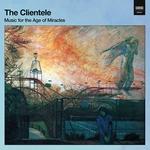
The Clientele Music for the Age of Miracles
(Merge)
It's been a long wait for a The Clientele album. After the release of Minotaur in 2010, the band took a long hiatus that ended in 2014 with a tour and the release of two singles. To many fans, it signified the imminent release of an album, yet it wasn't the band's game plan. Your average indie group would have strived to rush-release some product to fill the coffers, but The Clientele's creative process isn't aligned with marketing strategies. If you have followed the group over the years, you've learned that there's nothing remotely calculating about them.
Indie success comes with its own set of compromises. The Clientele have been around long enough to have witnessed many of their peers crash and burn. It's a risky business: that big record company may put you on the map, but it will demand a share of the creative decisions; that spotlight you crave will make you a media darling, but it will divert your time and energy away from music making. Frontman Alasdair MacLean is well aware of these pitfalls. Whether from instinct or wariness, he keeps the operation on a scale that allows him to survive as a musician and release albums that adhere to his creative vision. That uncompromising spirit is behind Music for the Age of Miracles, which has the integral strength of the band's best releases while expanding their universe with new textures and destinations.
The production is superbly atmospheric, matching MacLean's oneiric lyrics to aural images. Take for instance the album opener, The Neighbour, where the band' signature reverb-laden sound is augmented by cellos and flutes that bring to mind nocturnal walks and the hazy movements of moonlit dancers. The stream of consciousness lyrics aren't there to be decoded but to build moods and landscapes. There are tracks here that last over six minutes, but there's nothing draggy about them. Falling Asleep is a journey through lucid dreams that makes extensive use of a dulcimer as the anchor of an otherworldly trip with side tours to sixties folk rock and Indian trance music. Everything You See Tonight Is Different From Itself keeps the doors of perception open, adding a Brazilian rhythm and a fuzz guitar to the exotic instrumentation while MacLean sings about an empty face in an empty house and birds flying in from Africa. The Circus, with its renaissance touches, is a compelling sound sculpture. It seems the idea here is to capture a time-travel feeling, achieving it with actual instruments instead of studio-console tricks.
For MacLean, sounds, words, and paint correlate as means of expression. The Museum of Fog is the album's art piece, a collage built with a brisk melody and a subliminal narrative. For most of the album, the band works with large canvasses, yet there are also short instrumental pieces that resemble film music. The most intriguing of these is the piano-led North Circular Days, which sounds like something left behind by Chopin's in a dusty drawer.
Though the arrangements are complex, the band stays clear from the tropes of psychedelia, allowing plenty of breathing room for voice and melody. Everyone You Meet, for instance, recalls Forever Changes with its delicate blend of brass and strings. Lunar Days keeps the romantic rapport intimate with the aid of a gentle bossa nova beat and muted cellos. Constellations Echo Lanes and The Age Of Miracles could be ranked among MacLean's most haunting work, both displaying his armory as a top melodist.
I can't say we're living in the age of miracles, but this album makes me cautiously optimistic. For one, it abounds with fertile musical ideas, which is something that's been missing in our depleted cultural diet. In a world that's gone mad, this mesmerizing confection is like a balm, bewitching the listener with soothing reveries. For now, it stands as The Clientele's best. [Believe the Hype]
20 September, 2017 - 04:05 — Angel Aguilar